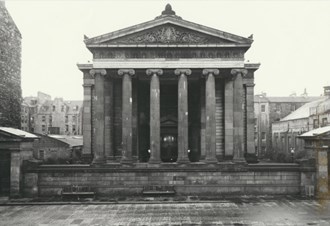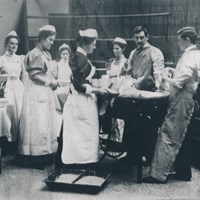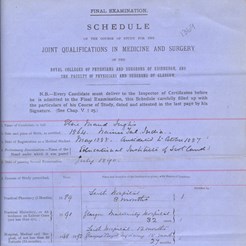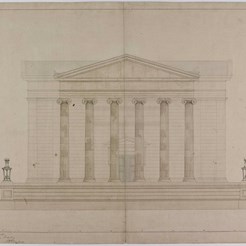We are delighted to announce that the Royal College of Surgeons of Edinburgh Institutional Archive is now available to researchers, with thousands of records now digitally available for the first time, and catalogued to item-level. Generously supported by the Wellcome Trust, the cataloguing and preservation of this archive formed part of a 2-year project to catalogue 5 key collections. In addition to the RCSEd Institutional Archive, other collections catalogued have included the Society of Barbers (covering the period post-1722 when the barbers separated from the surgeons); School of Medicine of the Royal Colleges, Royal Odonto-Chirurgial Society and the Lothian Surgical Audit. We have additionally digitised thousands of manuscripts from the Institutional Archive, which you can view through our catalogue (we are currently uploading batches of these images daily). You can view the new multi-level catalogue here by searching 'RCSEd' in the ref field or 'Papers of the Royal College of Surgeons of Edinburgh' in the title field (through advanced search with 'archive' box checked). You can also find a summary of series-level headings at the end of this blog.
RCSEd Archive
The barber surgeons in Edinburgh came together as an Incorporation in July 1505, when they were granted their Seal of Cause by the Town Council, and thus emerging as one of many trade guilds operating in the city. Spanning over 500 years, the RCSEd Institutional Archive is rich in all aspects of the College's illustrious history, and we are very fortunate indeed that so many of our records have been preserved over the last 5 centuries. The RCSEd archive is a unique historical resource detailing the activities, culture and development of an ancient craft guild, supporting a wide subject range, from the history of medicine, surgery and medical education, to local Edinburgh economic and social history. Significantly, with Edinburgh emerging as the seat of medical education in the 18th century, it is this context that provides much of the backdrop to the collection. Also reflected in the archive are the surgeons’ efforts to reform medical education in Britain and importantly, provide training for medical students in order to meet the demands of modern warfare. The scope of the collection is vast and comprises (although is not limited to): complete set of minute and sederunt books (from 1581); early apprenticeship records; extensive business, legal and financial records dating from the 16th century; Acts regarding the Incorporation of Surgeons and Barbers (later Royal College of Surgeons); papers relating to litigation involving the Town Council, surgeons, barbers and apothecaries and the Edinburgh Royal Infirmary; papers on the building of the 1697 Surgeon's Hall and Turkish Bathhouse "Bagnio"; papers relating to the Library, Archive and Surgeons' Hall Museums; William Playfair's original architectural drawings of the present Surgeons' Hall; letter books and correspondence; diplomas and extensive examination records from the 1700s; large manuscript scrolls; photographs; royal charters and records relating to Fellows, Licentiates and Membership.
Collection Highlights
It has proved near-impossible (painful almost!) to pick only a few highlights from such a large and diverse collection, but here goes...
College Minutes and Chirurgians' Business Papers
Our Minute Books form a continuous record from 1581, covering a wide range of subjects, from routine matters such as admission of new members and financial transactions, to the more curious, for instance, local cases of grave-robbing.
Importantly, the Minutes and early business papers (RCSEd 1, RCSEd 2) provide a window into the many civic and professional functions performed by Edinburgh surgeons or ‘chirurgians’ on a daily basis, also revealing how various medical practitioners such as barber surgeons, apothecaries and physicians worked together. Yet, a real highlight of the collection are the records exposing increasingly fractured relations between the barber-chirurgians, barbers, chirurgian apothecaries and ‘simple apothecaries’. Tensions between the barbers and chirurgians became particularly fraught during the 17th century, as the barbers found themselves increasingly marginalised politically in the Incorporation, as well as being banished from practising in the City, to the suburbs. A distinction had developed between the barbers, who simply cut and shaved hair, and the barber chirurgians, who also practised the more skilled craft of blood letting and other forms of surgery. The chirurgians gradually abandoned hair cutting and shaving, but frequent disputes arose between the two branches of the Incorporation concerning the rightful scope of their work and boundaries where they could practice. Such disputes are fully represented in the catalogue. For instance, you can find out what happened to the barber David Pringle, who was thrown in the Tolbooth Jail for allowing a barber to cut "the hair of the boys" in George Heriot’s Hospital, outside his jurisdiction. The document below is an Act by the Incorporation of Chirurgians of Edinburgh against Pringle, ordaining that he be imprisoned in the Tolbooth Jail for "employing a barber licensed to practice in Portsburgh only".
Financial Papers
The surgeons appear to have been meticulous recordkeepers, and as such, their extensive financial papers have survived 5 centuries. The earlier archives include around one-thousand financial documents, from apprentice bonds and discharges, to general accounts and charity papers. The document below from 1703 is an "Account of incident charges Disbursed by David Fyffe for the Chirurgions of Ed[inburgh]" and relate to the execution of David Myles in Edinburgh the previous year, for incest with his sister.
"weekly pensions...keeper of the wells...men for carrying David Mylles corps...sealing wax for tickets...two sentinels [sentry for criminal trials] for 6 days attendance...weights for weighing the body...carrying the body from the Gibbet [gallows] to [th]e church
Medical Education
From its earliest origins, the College has been an examining body. The 1505 Seal of Cause conferred various privileges upon the Incorporation, including the exclusive right of its members to practice surgery in Edinburgh and surrounding districts. The Incorporation made provision for both education and examination for prospective members. By 1581 there were 16 members of the Incorporation, with its members known as masters and entry was by passing an examination and paying a fee. This not only enabled them to practice their craft but also allowed them to take on apprentices. A particular highlight is the large series of beautiful 18th and 19th century indentures of apprenticeship, which include those of surgical luminaries Charles Bell, Robert Liston, John Lizars and James Syme; the selection below includes the 1792 indenture of anatomist Charles Bell to his surgeon-apothecary brother, John Bell. In addition to clauses concerning training and practice, the Indentures are particularly revealing for the strict terms apprentice surgeons were expected to abide by under their master, particularly with regard to morals:
"...nor shall have any Patients of his own under cure...nor shall he absent himself from his master's service at any time...he shall not commit the filthy Crimes of Fornication or adultery nor play any games whatsoever...he shall not be drunk, nor Night-Walker nor ahanuter of Debaucht or Idle company, nor go to ale-house, nor Taverns, to tiple or drink with any company whatsoever".
From 1645 the apothecaries were allowed to join the Incorporation and by the start of the 18th century the examination syllabus besides anatomy, surgery, bandaging and the dressing of wounds contained questions on pharmacy, botany and materia medica. The archive includes examination records of the Single and Double Qualifications, and as the administrative base of the Triple Qualification offered by the Scottish Royal Medical Colleges, we have a complete run of candidate records (these should be consulted in conjunction with the School of Medicine archive which you can read about here).
The TQ was particularly emancipating for women, whose gender denied them matriculation at any Scottish university until 1892. That same year, Elise Inglis (founder of the Scottish Women's Hospitals during WW1) was awarded the TQ, also becoming a Licentiate of RCSEd (the first female recipient of the TQ was in 1886). The TQ also acted as a magnet for students from overseas, including those evading political and religious exclusion or persecution, such as Nazi Germany. The TQ schedules contain not only biographical details of age of students, but also date of registration as a medical student, and a full details of courses taken and the names of teachers, including clinical work.
Elsie Inglis' TQ schedule (above) shows that she gained clinical experience at Leith Hospital, Glasgow Maternity Hospital and Glasgow Royal Infirmary (including its Dispensary) between 1889 and 1892, also taking additional classes at the Cowgate Dispensary, Maternity Hospital Edinburgh and Sick Children’s Hospital Edinburgh.
Charity provision
During the early modern period, Edinburgh surgeons worked as general practitioners to both the well-heeled and lower classes, thus the archive also offers an opportunity to explore the local social and economic context, as well as being a record of community-based medicine.
The barbers and surgeons also provided donations to the distressed in times of need, and there are many papers throughout the collection relating to their role as charity providers. In addition to papers relating to the Surgeons' Widows Fund established in 1778, the archive also contains records concerning nominations of inmates to the Trades Maiden Hospital, established in 1704 by the Craftsmen of Edinburgh and Mary Erskine (also see the Society of Barbers archive for extensive papers highlighting the precarious lives of barbers' families and charity provision to the Trades Maiden Hospital).
Old Surgeons' Hall and the Playfair Building
In the 16th century, the barber surgeons met in the home of the Incorporation's Deacon, or sometimes in the aisles of St. Giles Kirk. From 1647 they met in rooms of a tenement in Dickson's Close, however, when they applied to the Town Council for more bodies for dissection, this was approved on the condition that the Incorporation provide an anatomical theatre. Thus by 1697, the Incorporation occupied their new home in High School Yards, often known as "Old Surgeons' Hall".
In the late 17th century, the medicinal use of baths was becoming popular, and at Old Surgeons' Hall" the Incorporation constructed a Bagnio (Turkish bath-house) which the surgeons opened to the public in 1703 (RCSEd 8/1/2). Trouble was afoot however, and not just problems associated with the bagnio's construction and expense. The College Minutes reveal concerns of apparent inappropriate behaviour in the rooms of the Bagnio, with the decision taken that men and women were instructed to bathe on separate days! In a separate incident of Bagnio abuse, arrangements were made for ‘the doors leading to the bedrooms [to] be locked and neither master nor stranger enter these rooms at that time’.
The archive also contains hundreds of original architectural drawings by Scottish architect William Henry Playfair, who was responsible for designing the College's next new (and current) home on Nicolson Street. Playfair was the architect responsible for the neoclassical designs of the National Monument on Calton Hill, the National Gallery of Scotland and the City Observatory. In the 1820s, the College had sought new premises because the ‘Old Surgeons’ Hall’ building in High School Yards was deemed unsuitable for accommodating the growth in the number of surgeons, and also, the new Charles Bell and John Barclay pathology collections. The Surgeons’ Hall building, as designed by Playfair, opened in 1832.
And finally...There's been a murder!
Some of my favourite documents in the Institutional Archive are a large number of outsize scrolls, including the one pictured below, which concerns the 17th century murder of a local glasser in the Canongate area of Edinburgh by a local mason. The document is the very lengthy testimony provided by surgeons and apothecaries of the Incorporation. Perhaps a very early known case of forensics?
A further scroll from 1698, concerns a judicial summons of a surgeon against an apothecary, comprising 4 metres-worth of grievances, outlining the history of the chirurgians' struggle with the apothecaries.
Catalogue (RCSEd 1-13)
The archive is arranged into the following sections, which you can view to item-level online:
RCSEd 1 Legal, governance and related (1504-2001): Grants of Rights and Privileges and related (1567-1868); Acts of the Edinburgh Town Council of Edinburgh granting favours to the chirurgians (1504-1785); Acts of the Edinburgh Town Council concerning relations between the chirurgians, barbers, apothecaries and chirurgian-apothecaries (1561-1703); Dealings with the Town Council (1621-1770) Litigation (c.1600-1911); Papers relating to the 1778 Royal Charter (1788); Laws and regulations (1804-1983); Dispositions, petitions and related (1704-2001); Chirurgians incoming business papers (1660-1845); Inventories of Acts, Charters and other papers (1678-1841).
RCSEd 2 Minutes, administration, organisation (1581-2013): Minute Books of the Incorporation of Surgeons and Barbers of Edinburgh/RCSEd (1581-present); Minutes of Council; Membership/Fellowship records (1596-2013); College administration and organisation (1952-98); Miscellaneous (1937-2002).
RCSEd 3 Correspondence (1600-2008): Letter books (1811-1946); General correspondence (1600-1963-63); Office-bearers correspondence (1769-1857); Correspondence relating to the Old Hall at Surgeons' Square (1833); Correspondence relating to the Royal Family (1952-2008); Correspondence relating to "Victory in Europe" (1945-46); Correspondence involving the General Medical Council (GMC) (1935, 1931).
RCSEd 4 Financial records (1533-2011): Bonds, discharges, payments and related accounts (1533-1799); General accounts (1754-2011); Cash books (1925-1988); Records relating to employment and payment of officials of the Incorporation of Surgeons (1658-1774); Charity dispensed by the Incorporation of Surgeons and papers relating to the Surgeons' Widows Fund (1670-1890); Accounts relating to courses and examinations (1963-1988); Cash books of prize, bursary and lectureship funds (1876-1963); Triple Qualification accounts (1887-1978); Pension records (1979, 2001-02); Financial miscellaneous (1963-1985).
RCSEd 5 Medical and surgical education, training and practice (1653-2007): Indentures of apprenticeship (1653-1836); Enquiries and reports of committees and commissions (1944-93); Records of annual and joint clinical and scientific meetings (1972-2000); Standing Joint Committee of the Royal Scottish Medical Corporations (1968-74); Scottish Triple Qualification Committee of Management (1970-97); Joint Committee on Higher Surgical Training (1971-94); Specialist advisory committees (1973-79); Committee appointed to consider the present control over experiments on living animals (1963-65); Hospital Scientific and Technical Services Committee (1967); Working Party on Ambulance Training and Equipment (1960s); Working Party on Operating Theatres (1963-1964); Working Party on the Medical Staffing Structure in the Hospital Service (1958-59); Recognition of Hospital Appointments (1951-68); Edinburgh Postgraduate Board for Medicine (1939-1967); Miscellaneous committees and working parties (1894-2006); Speciality Advisory Board (2004-2007).
RCSEd 6 Examinations (1770-2010): Triple Qualification (1884-1996); Single and Double Qualification (1770-1959); Diploma in Public Health (1875-1942); Diploma in Psychological Medicine (1959-77); Fellowship examinations (1900-2009); Dental examinations (1879-1999); Immediate Medical Care Diploma and Fellowship (1988-2010); MRCSEd and AFRCSEd Ophthalmology (1997-2010); Membership, Associate Fellowship Surgery in General and Intercollegiate Membership Surgery (1996-2008); Overseas examinations (1974-2008); Examination statistics (1990-2002); Examinations miscellaneous (1929-2004).
RCSEd 7 Photographs: Photographs of Presidents, Fellows and other individuals (19th-20th century); Royal Family (1980-2005); Photographs of College silver, furniture and Coat of Arms (20th century); Photographs of Diploma Ceremonies (1952-2005); Conferences and social events (1965-2001); Miscellaneous (19th century -2006).
RCSEd 8 Buildings and land (1665-2007): Records relating to Old Surgeons' Hall, High School Yards and the “Bagnio” Turkish Bath-house (1696-1774); Records relating to the Playfair Building, Nicolson Street (1774-2005); Records relating to other College buildings (1975-2007); Papers on the feuing of land (1665-1807); Miscellaneous (1800s-2003).
RCSEd 9 Records relating to the College Museum, Library and Archive (1763-2015): Records relating to Surgeons' Hall Museum (1821-2015); Records relating to the College Library (1763-1998); Records relating to the College Archive (1920-2005).
RCSEd 10 Records relating to the Faculty of Dental Surgery (1946-2000): Papers relating to the background and creation of the Dental Faculty (1946-64); Faculty billets (1950-97); Reports, correspondence and associated papers (1994-2000); Meetings (1998-99); Printed material and publications (1963-99).
RCSEd 11 Papers relating to the Surgical Hospital/Royal Infirmary of Edinburgh (1729-1841).
RCSEd 12 Events, celebrations and social (1800-2005): 450th Anniversary (1955); Playfair Bicentennial celebrations (1990); Dental Faculty Golden Jubilee celebrations (1997-98); Quincentenary (2001-5); Diploma Ceremony (1989-2008); Entertainment and social (1800-1993).
RCSEd 13 Conferences and symposia (1962-2001).








 RCSEd Archive Catalogue
RCSEd Archive Catalogue
![playfair-6[1].jpg playfair-6[1].jpg](https://library.rcsed.ac.uk/media/1190/playfair-6-1.jpg?crop=0.17790184421221247,0,0.13828794209709577,0.0000000000000001155354041886&cropmode=percentage&width=246&height=246)










![cyril-dobie-2[3].jpg cyril-dobie-2[3].jpg](https://library.rcsed.ac.uk/media/1147/cyril-dobie-2-3.jpg?crop=0.1296998307226474,0,0.20558853682378461,0&cropmode=percentage&width=246&height=246)











